| 1. Boeing 737-500 take off click |
| 2. Mitsubishi EVO VII vs. VW Golf mk1 1.8 turbo virtual race click |
| 3. A lap over a high banked oval track. click |
| 4. Short slalom race click |
This log is also available
among the 1/8 mile runs. (click here)
Everyone who was on board a passanger airplane knows that it feels quite fast.
So I felt it's a must to log it... :)
Acceleration is almost constant until take off. The take off speed is around
200 km/h (124 mph)
Obviously with a g logger the log is only correct until the point where the
nose lifts off, because
from that point a percentage of gravity is also measured as if it was extra
acceleration.
note: After 11th September 2001, I was a little nervous of maybe
the security crew picking
out the logger for a bomb or something. :) But they weren't interested in it.
I tried to log around 4 trips, but except for this, the planes did a rolling
start.
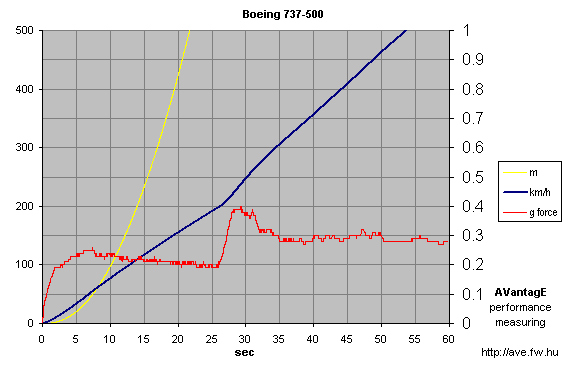
2. Mitsubishi EVO VII vs. VW Golf mk1 1.8 8v turbo virtual race (2002)
My friend told me
a story about his Golf being able to match the pace of an EVO VII.
Of course, I thought, maybe he wasn't trying. :) But then I realized I can compare
the two
as I had logs of both and could make up a comparison chart. So here it is.
It's a rolling start
from 100 km/h (62 mph) both cars are in 3rd gear.
It's very close until the gearchange, where a small hesitation of the Golf
(see whole run's log) lets the EVO a significant
speed advantage, so it starts to pull away,
and in 8 seconds it gains13 meters. But considering that the Golf was
in the EVO's slipstream, it's quite possible that he could have kept up.
note: This
started me to make the virtual racing feature,
now available on the site.
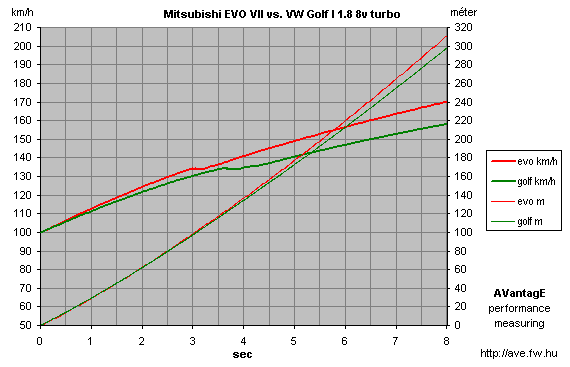
3. A lap over a high banked oval track. (2003)
Rabaring, a complex
test track in Hungary has a high banked oval track where
in a well prepared car you can keep your speed over 200 km/h (124 mph) in the
turns.
It feels fantastic even at around 160-170 km/h. (a
short video clip of the higher bank)
The oval is about 3 kilometers long, 2 long straight and two banked turns.
One is short & steep, the other is less steep but much longer. I had to
log a lap... :)
I wasn't trying to measure speed, instead I rotated my 2 axis g meter 90 degrees
down,
so instead of acceleration/deceleration I could log the force pushing the passengers
into the seats and the other axis kept its function, measured lateral g.
We logged the lap in a Honda Civic 1.8 Vtec (1/8 mile run here)
Let's see the chart.
First of all, negative values doesn't mean anything I just though
it's more easy to read the chart. The red line is the force pushing you down
into the seat,
the green is lateral g, and the yellow is the combined force.
Logging started 10 seconds before the steep turn from a rolling start.
First we tackled it quite gently with around 160 km/h. From 20 to 40 seconds
it's a straight,
in which we overtook another car. The long turn was tackled at around the same
speed,
maybe a bit more. From 65 s till 80 s it's again the high bank turn, but this
time the speed
was higher, around 170-180 km/h. With the increased speed the forces increased
too...
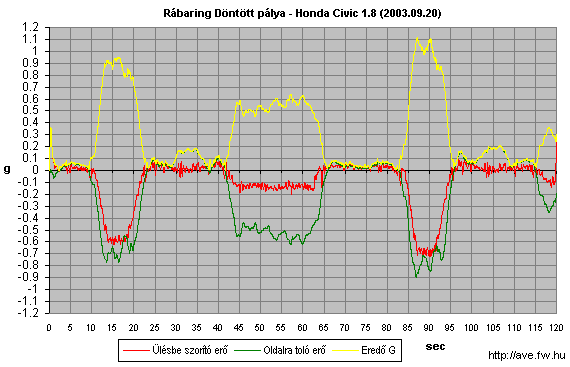
A short slalom race,
going round cones placed in a single line.
Here is short video clip showing
the track.
We logged two cars, a bog standard Renault Megane Break riding on 185/60R15
tires,
and a Mitsubishi Eclipse GSX (1/8mile run here)
lowered and stiffened on big alloys.
The Megane's best was 32.5 seconds the Eclipse did it in 28 seconds.
Unfortunately the logged runs' are not the best ones!
The chart shows lateral g foce vs. time.
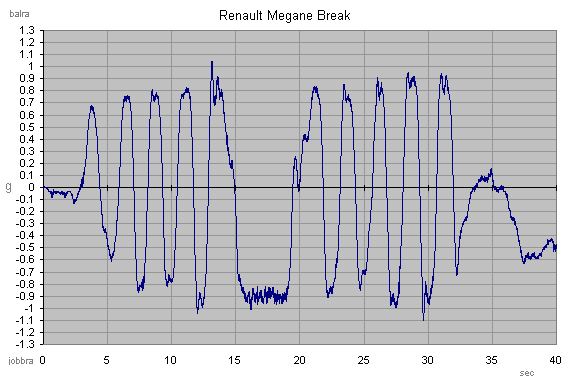
As you can see the
Megane starts the turnaround at around 15 seconds,
the Eclipse does it in a second earlier.
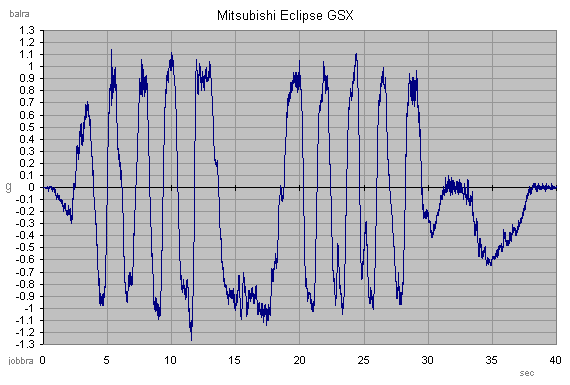

KISKUNLACHÁZA
OB ZÁZÓ FUTAM PART 1
Frissítve :
2010.09.11
